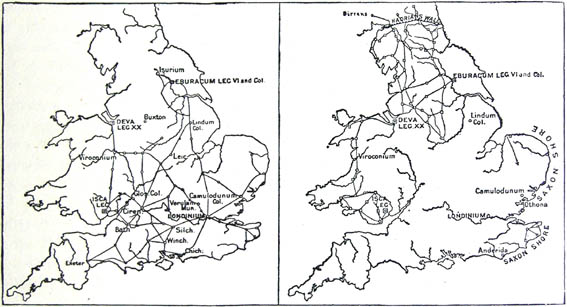|
region of forts, fortresses, roads, and
garrisons. The army which held it was perhaps 40,000 strong. It
counted as one of the chief provincial armies. It was also the
predominant element in Roman Britain.
With this military element, however, we are not here
concerned. We only note its existence in the north in order to
explain the rarity of Roman military remains in the south. Instead,
we have to examine the features of the non-military district, within
which Kent lies. They are not sensational. The province of Britain
was small, poor, and remote. It did not on the whole attain to the
higher developments of culture, of city life, and of commerce, which
abounded in more favoured lands—Gaul, or Spain, or Africa. It had,
nevertheless, a character of its own.
In the first place, like all western and central
Europe, Britain became Romanised. Sooner or later the natives
generally adopted Roman speech and many of the elements of Roman

Fig. 1 Illustrating the
difference in the Roman Occupation of the North and South of Britain
civilization, and the difference between 'Roman'
and ‘provincial’ gradually, but completely, vanished. When the
Roman rule in Britain ended, about A.D. 410, the so-called Departure
of the Romans did not mean what the end of English rule in India or
of French rule in Algeria would mean to-day. It was not an
emigration of alien officials, soldiers, and traders. Probably it
was not an emigration at all. Rome ceased to send to Britain certain
high civil and military officials, and withdrew or ceased to
reinforce the troops in the island. But these officials were few and
the troops had probably by this time come to consist largely of
local levies. On the other hand, the gap between Roman and Briton,
visible enough in the first century, had become almost obliterated
by the fourth century. The country folk in the remoter parts of
Britain—and in particular in the military districts—may have
continued to speak Celtic throughout the Roman period. That is a
problem which needs further investigation. But the townspeople of |